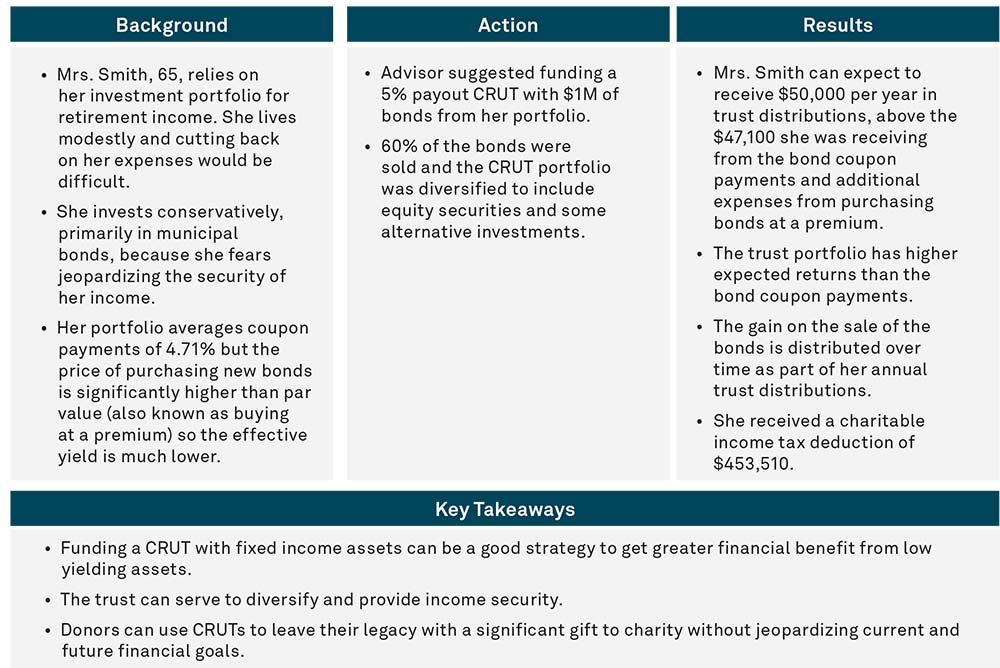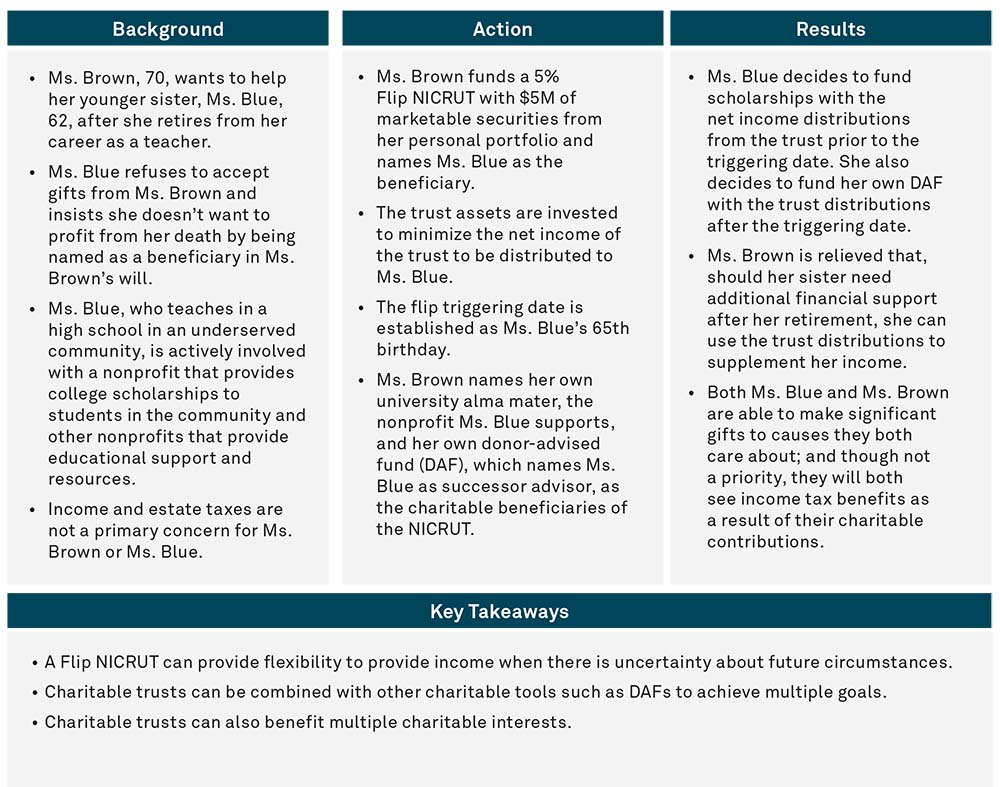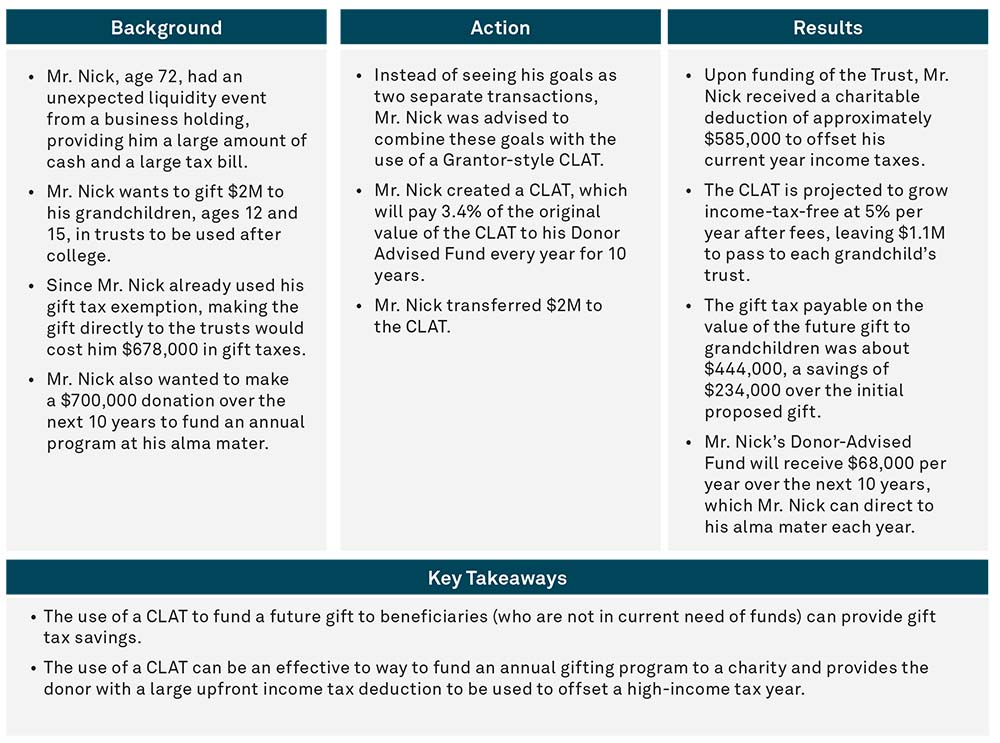Donors can use charitable trusts to benefit the causes they care about while also seeing a financial benefit.
A charitable trust can be a used as a flexible and effective strategy to help donors meet philanthropic goals while providing income and estate tax benefits. Trusts are structured based on each donors’ unique needs and goals to optimize both charitable and tax benefits as well as the financial benefit to beneficiaries. Through careful consideration of funding assets, payout structure, trust period and other terms, trusts can offer creative solutions to planning challenges.
This guide provides an overview of different charitable trusts while illustrating how they can be structured to maximize impact for both the donor and beneficiary.
Charitable remainder unitrust (CRUT)
A Charitable Remainder Unitrust, or CRUT, is an irrevocable trust that provides distributions to beneficiaries for life or a fixed term up to 20 years. The amount of the distribution is based on a fixed percentage (5% or greater) of the net fair market value of the trust’s assets and is recalculated annually. The assets remaining in the trust at termination pass to charity.
Illustration 1: Replacing Bond Cash Flow for Retirement Income from a CRUT
The following illustration highlights how CRUTs can be used to generate regular income to meet lifetime income needs and create a charitable legacy as part of an integrated wealth plan.

Net income charitable remainder unitrust (NICRUT)
A Net Income Charitable Remainder Unitrust, or NICRUT, is a CRUT that provides distributions to beneficiaries of the net income earned in the trust. NICRUTs can have a “flip” provision which will change the distribution amount from the trust’s net income to that of a standard fixed percentage CRUT. The trust can “flip” to a standard fixed percentage on a specific date (“triggering date”) or event (“triggering event”) that is not discretionary or within any person’s control.
Illustration 2: Using a "Flip" NICRUT to Benefit a Sibling in Retirement - Or Not
The illustration below demonstrates how a “flip” NICRUT can be used to provide for future family income needs.

Charitable lead trust (CLT)
A Charitable Lead Trust, or CLT, is an irrevocable trust that makes current distributions to charity of a fixed amount or percentage of the trust assets for the trust term. Upon termination, the remaining trust assets pass to any person designated by the grantor at the inception of the trust. CLTs can be offered in two forms: Charitable Lead Annuity Trust (CLAT) and Charitable Lead Unitrust (CLUT), the difference being the method used to calculate the payment to charity.
Illustration 3: Using a Charitable Lead Trust to Leverage Gift Tax Exemption and Reduce Current Income Taxes
As shown in the following illustration, a Charitable Lead Trust can be used to satisfy both charitable intentions and future gifts to grandchildren at a reduced gift tax cost.

Conclusion
These are just a few examples of how charitable trusts can be used creatively. With thoughtful planning in consultation with a trusted advisor, donors can use charitable trusts to benefit the causes they care about while also seeing a financial benefit.
This material is provided for illustrative/educational purposes only. This material is not intended to constitute legal, tax, investment, or financial advice. Effort has been made to ensure that the material presented herein is accurate at the time of publication. However, this material is not intended to be a full and exhaustive explanation of the law in any area or of all the tax, investment, or financial options available. The information discussed herein may not be applicable to or appropriate for every investor and should be used only after consultation with professionals who have reviewed your specific situation.
The Bank of New York Mellon, DIFC Branch (the “Authorised Firm”) is communicating these materials on behalf of The Bank of New York Mellon. The Bank of New York Mellon is a wholly owned subsidiary of The Bank of New York Mellon Corporation. This material is intended for Professional Clients only and no other person should act upon it. The Authorised Firm is regulated by the Dubai Financial Services Authority and is located at Dubai International Financial Centre, The Exchange Building 5 North, Level 6, Room 601, P.O. Box 506723, Dubai, UAE.
The Bank of New York Mellon is supervised and regulated by the New York State Department of Financial Services and the Federal Reserve and authorised by the Prudential Regulation Authority. The Bank of New York Mellon London Branch is subject to regulation by the Financial Conduct Authority and limited regulation by the Prudential Regulation Authority. Details about the extent of our regulation by the Prudential Regulation Authority are available from us on request. The Bank of New York Mellon is incorporated with limited liability in the State of New York, USA. Head Office: 240 Greenwich Street, New York, NY, 10286, USA.
In the U.K. a number of the services associated with BNY Mellon Wealth Management’s Family Office Services– International are provided through The Bank of New York Mellon, London Branch, One Canada Square, London, E14 5AL. The London Branch is registered in England and Wales with FC No. 005522 and BR000818.
Investment management services are offered through BNY Mellon Investment Management EMEA Limited, BNY Mellon Centre, One Canada Square, London E14 5AL, which is registered in England No. 1118580 and is authorised and regulated by the Financial Conduct Authority. Offshore trust and administration services are through BNY Mellon Trust Company (Cayman) Ltd.
This document is issued in the U.K. by The Bank of New York Mellon. In the United States the information provided within this document is for use by professional investors.
This material is a financial promotion in the UK and EMEA. This material, and the statements contained herein, are not an offer or solicitation to buy or sell any products (including financial products) or services or to participate in any particular strategy mentioned and should not be construed as such.
BNY Mellon Fund Services (Ireland) Limited is regulated by the Central Bank of Ireland BNY Mellon Investment Servicing (International) Limited is regulated by the Central Bank of Ireland.
Trademarks and logos belong to their respective owners. BNY Mellon Wealth Management conducts business through various operating subsidiaries of The Bank of New York Mellon Corporation.
©2023 The Bank of New York Mellon Corporation. All rights reserved. | WM-421014-2023-08-30
